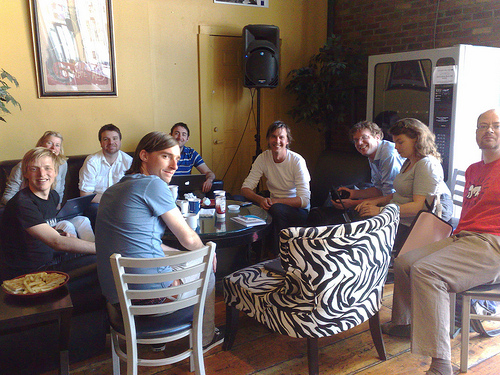 [This week’s guest post is written by Mia Ridge, Lead Web Developer, The Science Museum]
[This week’s guest post is written by Mia Ridge, Lead Web Developer, The Science Museum]
I will start with a confession: the title of this post is really a lie – I’m mostly writing about the last fortnight in cultural heritage. As one of those stranded overseas by Iceland’s volcanic ash, my post-Museums and the Web conference week was oddly disrupted, and it’ll be a while longer again before I’m caught up on everything else I was meant to be doing in those eight days.
I arrived in Denver early to take part in the Wikimedia@MW2010 workshop. I’ve been reflecting on the results for several days, and I’d love to hear others’ thoughts on it. At first, I felt that museums and Wikimedia were two ships that passed in the night, however friendly and well-intentioned the waving between them. I didn’t feel we really engaged with the big issues between museums and Wikimedia on the day, though perhaps this was too much to expect with a large group in just one day. Each group is decentralised – individual Wikimedians must answer to the distributed community of Wikimedians, and a single museum cannot speak for any other museum – so while there was lots of interesting discussion, it’s difficult to pinpoint any big headline outcomes from the meeting.
However, in the short term the real result will probably be lots of smaller partnerships that will map the path to future discussions through their successes and failures. It may be that the only way to really understand each other is to encounter and resolve a thousand tiny misunderstandings. I hope that these projects will help us learn more about each others’ motivations, difficulties and issues (perhaps even to understand enough to feel empathy) so that we can work together to help everyone access quality content and experiences online. After all, as one of the keynote speakers said, ‘we’re all dedicated to preserving human knowledge’.
Discussions about automated harvesting and publishing at the technical breakout session started me thinking about what become one of the themes I mused on of the rest of conference. While there are basic technical issues that we need to solve to provide a core level of service to the wider community, we will always need curators to define and select objects and stories that are of more intrinsic interest. We all have hero objects, and we all have more widgets than heroes, even if your widgets are pottery sherds or flying ants rather than spark plugs.
I think we will also see an increasing demand for curators, educators and specialists who can communicate with distributed communities of visitors who want to continue accessing and learning with collections regardless of the barriers of time and space.
Personal highlights of the MW2010 conference were Thursday’s ‘Collections: Tag / Search / Deploy’ papers, and the unconference. [At that stage we didn’t know we’d be holding a few more to keep ourselves occupied while grounded] There were several interesting papers I didn’t get to see in other sessions – luckily all the papers are online so I can catch up with them later. I was also involved in the creation of the Spinny Bar Historical Society, which effectively demonstrated that with a bit of know-how, several social media addicts and about $100 you could create an effective, multi-channel online presence for a small organisation in just 24 – 48 hours. The SBHS even has a collections management system, though we admit that in this case it did help to have their CEO at the conference.
The end of the conference was somewhat overshadowed by anxious thoughts of being stranded in Denver. As those fears turned to reality, we were able to make the most of it, organising further unconferences, meals and frisbee sessions as well as simply banding together and working in the same space.

The ‘mobile games’ post-MW2010 unconference session at Leela’s Cafe
